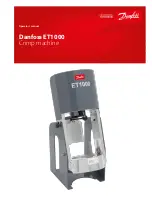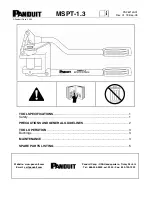
placement easier, for instance on framing, toe nailing and crating applications. The sequential actuation mode
allows exact fastener location without the possibility of driving a second fastener on recoil, as described under
Contact Actuation Mode (below). The sequential actuation mode has a positive safety advantage because it will
not accidentally drive a fastener if the tool is contacted against the work - or anything else - while the operator is
holding the trigger pulled.
CONTACT ACTUATION MODE
The common operating procedure on “Contact Actuation Mode” or “Bump Mode” tools is for the operator to
actuate the safety yoke while keeping the trigger pulled, thus driving a fastener each time the work is contacted.
This will allow rapid fastener placement on many jobs, such as sheathing, decking and pallet assembly. All
pneumatic tools are subject to recoil when driving fasteners. The tool may bounce, releasing the safety yoke and
if unintentionally allowed to re-contact the work surface with the trigger still actuated (finger still holding the
trigger pulled) an unwanted second fastener will be driven.
Warning:
Tools must NOT be used in Contact Actuation Mode where changing from one working
position to another involves the use of ladders, stairs or similar structures such as roofs
SELECTING THE ACTUATION MODE (Fig 16-17):
To change the actuation mode, rotate the switch in the counterclockwise direction. The switch will lock
automatically when the indicating arrow is pointing down to the 3 nail icon stamped into the tool frame
(Contact Actuation Mode) or to a single nail icon stamped in the tool frame (Sequential Actuation Mode).
TOOL OPERATION CHECK
CAUTION:
Remove all fasteners from tool before performing tool operation check.
m
WARNING!
If the tool has been dropped or you suspect tool damage perform tool operation check as defined
in the tool operation check section.
FULL SEQUENTIAL TRIP OPERATION
A) Without touching the trigger, press the safety yoke against the work surface.
THE TOOL MUST NOT CYCLE.
B) Hold the tool off the work surface and, avoiding to point the tool at self or others, pull the trigger.
THE TOOL MUST NOT CYCLE.
C) With the tool off the work surface, pull the trigger. Press the safety yoke against the work surface
THE TOOL MUST NOT CYCLE.
D) Without touching the trigger, press the safety trip against the work surface then pull the trigger.
THE TOOL MUST CYCLE.
E) With the safety trip still pressed against the work surface, pull the trigger again.
THE TOOL MUST NOT CYCLE.
CONTACT ACTUATION OPERATION
A) With the finger off the trigger, press the safety yoke against the work surface.
THE TOOL MUST NOT CYCLE.
B) Hold the tool off the work surface and, avoiding to point the tool at self or others, pull the trigger.
THE TOOL MUST NOT CYCLE.
C) With the tool off the work surface, pull the trigger. Press the safety yoke against the work surface
THE TOOL MUST CYCLE.
D) Without touching the trigger, press the safety yoke against the work surface then pull the trigger.
THE TOOL MUST CYCLE.
Summary of Contents for BT1855SP-A
Page 3: ......
Page 5: ...FIG 13 FIG 15a FIG 17 FIG 21 FIG 22 FIG 18 FIG 19 FIG 20 FIG 15b FIG 16 FIG 14 ...
Page 15: ......


































